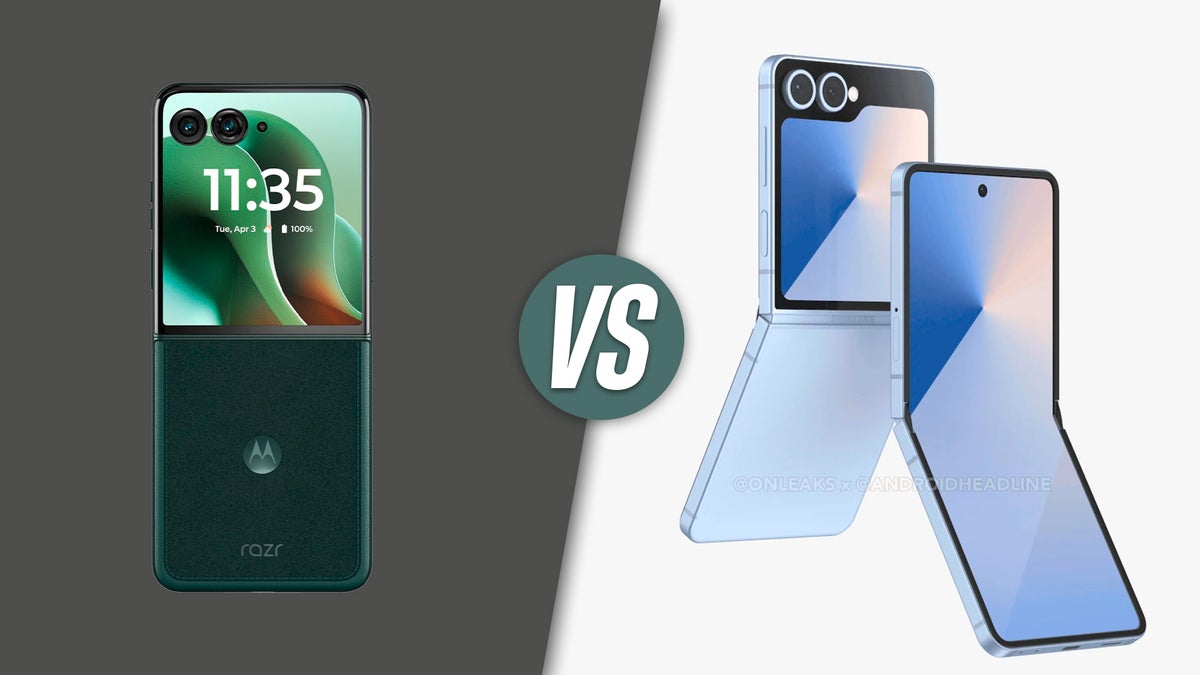Motorola Razr Plus (2025) vs Galaxy Z Flip 7 Preview: A closer battle than ever
Intro
This year, however, the Razr Plus (2025) is not Motorola’s most premium foldable phone. Instead, that role is taken by the new Razr Ultra, which is a closer match to the newly announced Galaxy Z Flip 7 in terms of performance.
But will the Razr Plus (2025) still be a good and more affordable alternative to the Z Flip 7? Now that Samsung’s summer Unpacked event has taken place, we have official answers.
Motorola Razr Plus (2025) vs Galaxy Z Flip 7 differences:
| Motorola Razr Plus (2025) | Galaxy Z Flip 7 |
|---|---|
| Snapdragon 8s Gen 3 | Exynos 2500 |
| 12 GB RAM | 12 GB RAM |
| 6.9-inch main display, 165Hz | 6.9-inch main display, 120Hz |
| 4-inch cover screen, 165Hz | 4.1-inch cover screen, 120Hz |
| 50 MP main 50 MP 2x telephoto 32 MP selfie |
50 MP main 12 MP ultra-wide 10 MP selfie |
| 4,000 mAh | 4,300 mAh |
| 45W wired charging 15W wireless |
25W wired charging Supports wireless charging |
| Android 15 4 years OS updates |
Android 16 7 years OS updates |
| Vegan leather w/stitching wood finish options |
Glass back Gorilla Glass Victus 2 |
| IP48 | IP48 |
| $1,000 | $1,099 |
Table of Contents:
Design and Size
Motorola shines with its style, Samsung refines its build
The Razr Plus (2025) sticks to its fashionable roots with a leather-inspired finish in three standout colors: Midnight Blue, Hot Pink, and Pantone’s 2025 Color of the Year — Mocha Mousse. It remains lightweight, slim, and soft to the touch.
Samsung’s Galaxy Z Flip 7, on the other hand, keeps its premium aluminum and glass build but makes a series of important refinements. It maintains the same IP48 durability rating as last year, but now adds a new layer structure to the Ultra Thin Glass (UTG) of the main display.
According to Samsung, this new layering improves shock dispersion and makes the crease less visible, a direct response to one of the most persistent criticisms of the Flip line. That said, we didn’t notice that big of a difference during our hands on with the Z Flip 7 as far as the crease visibility is concerned.
Display Differences
- Next Move – context-aware suggestions based on what’s on screen
- Playlist Studio & Image Studio – create themed playlists and visuals
- Catch Me Up – summarizes missed notifications
- Pay Attention – transcribes audio
- Smart Connect – mirror content to TVs and PCs via voice/text
The Flip 7’s cover screen now supports full-screen message replies, more interactive widgets, and a new suggested reply system powered by Galaxy AI. It still lacks full third-party app support out of the box, but tries to make up for it with tighter integration with One UI.
Both phones have a 6.9-inch internal display with HDR10+ support, but the Razr uses a 165Hz pOLED panel while the Z Flip 7 sticks to a 120Hz AMOLED one. Samsung’s folding crease is less visible this year thanks to a new Ultra Thin Glass layer with improved shock dispersion, but still not better than on the Razr.
Performance and Software
Mid-range Snapdragon vs flagship Exynos
Samsung, on the other hand, is using the new Exynos 2500 chip inside the Galaxy Z Flip 7. This marks the return of Samsung’s in-house silicon to foldables and introduces its first 3nm processor, with improvements in AI processing and power efficiency.
One major advantage for Samsung is software support: the Z Flip 7 gets 7 years of OS and security updates, compared to 4 years promised for the Razr Plus (2025). If long-term value is important, that’s a big win for Samsung.
Camera
Motorola still lacks an ultra-wide lens
The Razr Plus (2025) sticks with a dual-camera setup that features a 50 MP main camera and a 50 MP 2x telephoto lens, along with a high-resolution 32 MP selfie camera. To make the camera experience better, Motorola has leaned on Moto AI for auto photo enhancements and new features like Action Shot, Group Shot, and Air Gesture.
However, there’s still no ultra-wide camera on the Razr Plus, which was a major downfall for its predecessor during our Camera Score last year. That said, I tend to need zoom more often than a wider angle shot.
The Galaxy Z Flip 7 keeps the 50 MP main sensor and a 12 MP ultra-wide camera. Selfies are handled by a 10 MP front camera, and while the resolution is lower, Samsung’s processing may still offer competitive results.
The Flip 7 also gets AI-powered photo editing, including Generative Edit and Suggestion tools built directly into the gallery app.
Battery Life and Charging
Might be similar in battery life, but the Motorola will charge faster
Both foldables feature a 4,000 mAh battery, but Samsung remains more conservative with its 25W wired charging (0–50% in 30 minutes) compared to Motorola’s blazing-fast 45W charging (100% in ~45 minutes). Both support wireless charging and reverse wireless charging.
Battery endurance should be similar, though the different displays and chips may result in some differences.
Specs Comparison
| Motorola Razr Plus (2025) | Galaxy Z Flip 7 specs |
|---|---|
| Size, weight 171.4 x 74 x 7.1 mm 189 g |
Size, weight 166.7 x 75.2 x 6.5mm 188 g |
| Screen 6.9″ main display 165Hz refresh rate 4″ cover display 165Hz refresh rate |
Screen 6.9″ main display 120Hz refresh rate 4.1″ cover display 120Hz refresh rate |
| Processor Snapdragon 8s Gen 3 3nm |
Processor Exynos 2500 4nm |
| Versions: 12/256 GB |
Versions: 12/256 GB 12/512 GB |
| Cameras: 50 MP main 50 MP 2x zoom 32 MP front |
Cameras: 50 MP main 12 MP ultra 10 MP front |
| Battery: 4000 mAh |
Battery: 4300 mAh |
| Charging: USB-C 45W wired 15W wireless |
Charging: USB-C 25W wired 15W wireless |
Summary
The Galaxy Z Flip 7 brings meaningful upgrades that address last year’s pain points. It’s ships with Samsung’s new Exynos 2500 processor — a 3nm chip designed to unlock faster AI performance and better power efficiency. It also finally matches the Razr with its larger 6.9-inch inner screen and the new 4-inch cover display.
Motorola’s lean software and faster charging make the Razr Plus a strong case, especially if you’re not after flagship-level performance or extremely long software support. If you don’t mind the telephoto camera that replaces the ultra-wide one, it just might be the better purchase. Stay tuned for our full comparison with test results and camera samples!





